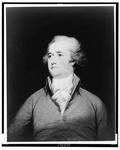 |
 |
On September 14, 1786, the Annapolis Convention came to a close.
Well, sort of.
The reality is that it never really got started. Only five of the states were represented by just a dozen delegates. And that wasn’t nearly enough representation to really get any business done. But that’s not to say nothing was accomplished at this non-Convention.
First off, the small number of people kept the meeting short…the Convention lasted just three days. Second, sparse attendence allowed for a greater comraderie and intimacy among those present, which meant the discussions freely ranged far beyond just those listed on the itinerary (interstate commerce and trade problems) to more fundamental issues, like the weaknesses of the Articles of Confederation.
In fact, the focus came to be on the Articles themselves, and this was probably the most important result of the gathering. Chernow writes, “The Annapolis attendees soon agreed that the commercial disputes among the states were symptomatic of underlying flaws in the political framework, and they arrived at a breathtaking conclusion: they would urge the states to send delegates to a convention in Philadelphia the following May to amend the Articles of Confederation.”
It fell to Alexander Hamilton (shown on the left) to write the appeal urging states to attend, but it was so strongly worded that Edmund Randolph asked him to tone it down. Hamilton bristled at the request, but James Madison (shown on the right) took him aside and urged him to give ground, warning him that such stout language would alienate Virginia (whose support would be essential). Hamilton took the advice and softened the letter’s tone.
As it turns out, the legislature in Hamilton’s home state of New York was absolutely opposed to the recommendations of the Annapolis address, thanks in large part to Governor George Clinton’s strong stance against it. In Madison’s (and Edmund Randolph’s) state of Virginia, however, the letter was welcomed with enthusiasm and, early on, George Washington was selected to lead the delegation that eventually attended the Constitutional Convention.
The other good thing…well, great thing…that came from Annapolis was the renewing of the friendship between Hamilton and Madison. They probably hadn’t seen each other since their congressional days, and this time together put them on the same page concerning the need for a change in the governmental structure. And while they would eventually become intense rivals, that was several years down the road. In the meantime, there would be Philadelphia (where both play crucial roles), and together they would pen nearly all of the Federalist Papers, quite possibly the finest collection of essays that has ever defended a national charter.
The Annapolis Convention may have been brief, and it may have been sparsely attended, but its effects are (thankfully) still with us more than two centuries later.
Recommended Reading: Alexander Hamilton

